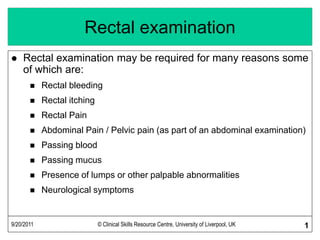
Rectal Examination
- 1. 9/20/2011 © Clinical Skills Resource Centre, University of Liverpool, UK 1 Rectal examination Rectal examination may be required for many reasons some of which are: Rectal bleeding Rectal itching Rectal Pain Abdominal Pain / Pelvic pain (as part of an abdominal examination) Passing blood Passing mucus Presence of lumps or other palpable abnormalities Neurological symptoms
- 2. Preparing the patient 1 9/20/2011 © Clinical Skills Resource Centre, University of Liverpool, UK 2 Introduce yourself fully including your role within the patients care The reason and nature of the technique of rectal examination should be explained to the patient, informed consent can then be gained. Reassure the patient the that examination may be uncomfortable, but it should not be painful The clinical room must be appropriate for an intimate examination and a chaperone present for the duration A private area for the patient to undress from the waist down should be available and a cover for the patient provided
- 3. 9/20/2011 © Clinical Skills Resource Centre, University of Liverpool, UK 3 Preparation of patient 2 Patient should be asked to lie in the lateral position, close to the edge of the bed with the hips and knees flexed. Expose only as much as necessary. A blanket should be draped across the patient to minimize exposure and reduce level of patients vulnerability Assistance by yourself or the chaperone should be offered to help the patient get into position Have a clean tray containing water soluble gel and tissues
- 4. 9/20/2011 © Clinical Skills Resource Centre, University of Liverpool, UK 4 Inspection of the anus Wash hands and don a pair of disposable gloves Gently separate the buttocks and inspect the natal cleft and anal verge Look for fissures, rashes, haemorrhoids, warts etc The position of an anal lesion is described in relation to the face of a clock The anterior aspect of the anus is assigned to 12 o’clock
- 5. 9/20/2011 © Clinical Skills Resource Centre, University of Liverpool, UK 5 Rectal examination technique 1 Lubricate (gloved) index finger Place pulp of index finger on posterior anal verge so a small angle exists between the palmar surface of the finger and the natal cleft Press gently on the anus and slip the tip of the index finger into the anal canal by increasing the angle of the finger Avoid using force, wait for the sphincter to relax, if still difficult do not continue with the examination
- 6. 9/20/2011 © Clinical Skills Resource Centre, University of Liverpool, UK 6 Rectal examination technique 2 Insert the index finger into the rectum as far as it will go, following the sacral curve If there is believed to be a problem with the anal sphincter, ask the patient to squeeze the examining finger to assess anal tone Examine the posterior and lateral walls of the rectum for palpable lumps or tears (rectal walls should be smooth) Assess the presence or absence of faeces: palpable as a mobile putty-like substance (in constipation may be hard), which you can indent with your fingertip.
- 7. 9/20/2011 © Clinical Skills Resource Centre, University of Liverpool, UK 7 Rectal examination technique 3 Rotate wrist so that finger pulp faces anteriorly and examine the anterior rectal wall. In the male examine the prostate gland (see slide 10) may be palpated. In the female the cervix may be palpable.
- 8. Rectal examination technique 4 Rotate wrist, so that your examining finger is facing posteriorly again and then withdraw finger. On withdrawal check gloved finger for stool (normal colour, pale stool, malaena etc) and any blood or mucus Clean patient, dispose of gloves and wash hands 9/20/2011 © Clinical Skills Resource Centre, University of Liverpool, UK 8
- 9. 9/20/2011 © Clinical Skills Resource Centre, University of Liverpool, UK 9 Prostate Examination The prostate gland is examined during a male rectal examination. A normal prostate measures approximately 3.5cm from side to side and protrudes 1cm into the rectum. It can be felt through the anterior rectal wall and has a median sulcus separating the two lobes. The prostate should not be tender to palpation but the patient may experience discomfort or an urge to urinate.
- 10. 9/20/2011 © Clinical Skills Resource Centre, University of Liverpool, UK 10 Palpation of the Prostate Gland Palpation of the prostate gland aims to assess: Size Presence of two equally sized lobes with a median sulcus Consistency (firm) Surface (smooth or nodular) Tenderness However assessment of prostatic size is learnt through experience!
- 11. 9/20/2011 © Clinical Skills Resource Centre, University of Liverpool, UK 11 Abnormalities of the Prostate Benign Hypertrophy of the prostate is common in men over the age of 60years. The enlargement is smooth and maybe unilateral or bilateral the gland feels rubbery or slightly boggy. A cancerous prostate may feel asymmetric, with a stony hard consistency maybe with the presence of palpable nodules Tenderness of the prostate may be due to prostatic inflammation or infection. All findings must be documented and further investigations/treatment/management must be considered.
- 12. 9/20/2011 © Clinical Skills Resource Centre, University of Liverpool, UK 12 Recording your findings Don’t forget when recording your findings to include the patient identifiers, date (and time), your signature and printed name at end When documenting or describing your findings remember to comment on the anus (inspection), anal tone (if performed), rectal walls, contents of rectum (stool etc), the prostate (see slide 11) and any abnormal masses palpated. Remember to describe your findings as fully as possible: eg size, position (relative to face of clock), shape of a swelling etc A diagram may often be useful in written notes